The constraints and struggles we face in stroke rehab are daunting... Too often it feels like we're left to choose between upper and lower extremity or accept diminished function and unfulfilled rehab potential.
Well, it's time to think outside the box... because it doesn't have to be that way!
Try something new and discover the keys to improving prognosis after a stroke at this comprehensive 2-day certification event featuring leading stroke rehab expert Mike Studer, PT, DPT, MHS, NCS, CEEAA, CWT, CSST, FAPTA.
By exploring how the principles of neuroplasticity and motor learning work together, you'll be able to personalize care by presentation, person, and performance.
PLUS, you'll be one of the first clinicians to become eligible to be a Certified Stroke Rehabilitation Professional (CSRP)* through Evergreen Certifications.
Here's a sneak peek at what you'll examine in this first-of-its-kind live training:- The mechanisms of neuroplasticity — why and how the brain reorganizes
- The difference in ischemic and hemorrhagic stroke — and how that impacts rehab
- The myths of stroke — UE vs. LE, timing of rehab, and "where gains come from"
- Adaptable interventions for the physical and cognitive changes for UE and LE
- Spasticity vs. tone — differences, precursors, and the treatments for each
- How to enhance patient compliance with behavioral economics concepts like gamification and more
- Cognitive rehabilitation — dual task tolerance, function, impulse control, affect, and awareness
- The future of stroke rehab — progress in technology and science
Patient beliefs and self-efficacy are more important than we ever realized — and they are both malleable. Learn how to prime the reward centers for possible success as you expertly balance patient autonomy, challenge, failure, and wins as part of your treatment plan.
And best of all? You can earn your CSRP credentials at no additional cost (a $199.99 value).
Let unfulfilled rehabilitation potential be a thing of the past!
Stroke Rehab Certification
Just $399.99 Today!
Not sure of your schedule? No problem! Pre-order the self-study version here!
FREE BONUS! CSRP Certification (a $199.99 value) included!
- 2 days of live expert-led training, November 6-7, 2023
- Interactive Q&A with expert Mike Studer
- Complete set of course materials to become a Certified Stroke Rehabilitation Professional*
- Up to 12 live and 8 self-study CE hours
- Completely flexible learning for your busy schedule
- Unlimited access to all conference sessions and handouts
- Complete set of course materials to become a Certified Stroke Rehabilitation Professional*
- Up to 20 self-study CE hours
Just $399.99 Today!
Not sure of your schedule? No problem! Pre-order the self-study version here!
FREE BONUS! CSRP Certification (a $199.99 value) included!
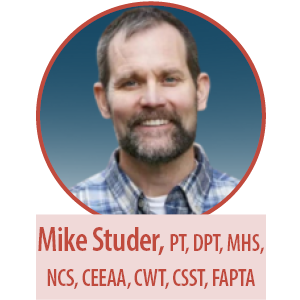 Join your expert presenter Mike Studer, PT, DPT, MHS, NCS, CEEAA, CWT, CSST, FAPTA, for two days of live presentations! The live webinars are held Monday, November 6 from 8:00 AM–5:45 PM Eastern and Tuesday, November 7 from 8:00 AM–11:45 AM Eastern. Click here for information about Mike Studer.
Join your expert presenter Mike Studer, PT, DPT, MHS, NCS, CEEAA, CWT, CSST, FAPTA, for two days of live presentations! The live webinars are held Monday, November 6 from 8:00 AM–5:45 PM Eastern and Tuesday, November 7 from 8:00 AM–11:45 AM Eastern. Click here for information about Mike Studer.2-Day: Stroke Rehab Certificate: How to Maximize Functional Recovery
Neurophysiology of Stroke: How the Principles of Neuroplasticity and Motor Learning Work Together
- Mechanisms of neuroplasticity- why and how the brain reorganizes
- Recovery of motor control vs. compensations
- How the brain uses habituation, adaptation, and compensation for functionality
- Therapeutic applications for introducing constraints, incentives, and avoidances in neuroplasticity
- Understand the difference in ischemic and hemorrhagic stroke – and how that impacts rehab.
- When should rehab start? When can intensity start? When is someone “neurologically ready”?
- How your interventions promote change
- Debunk the myths of stroke: UE vs. LE; timing; and “where gains come from”
- Balance the elements of challenge, gamification, success, and failure to maximize neuroplasticity for each patient
- Apply autonomy as a catalyst for patient engagement
- Prime reward centers for possible success – beliefs are more important than we ever realized
- Shift to external, goal-focused feedback to increase retention of motor skills
- Spasticity vs tone: differences, precursors and the treatments for each
- Goal action coupling – and how this can deepen patient engagement
- Time spent, time expectations and reptations are largely under-dosed for UE
- Why you may want to focus on the hand first instead of the shoulder
- Integrate tasks that force sensory information and motor contribution
- Induce neuroplasticity with graded motor imagery: L/R discrimination and mirror therapy
- Utilize bilateral challenges to increase mirror neuron benefit, intensity, gamification, accountability, and functionality
- Forced use applications for UE
- Applications in overtraining: HIIT, error-enhanced learning, and amplifying error
- Add a dual task to increase intensity and attention
- Forced use applications for LE
- HIIT and high-intensity gait training
- What is HIIT, what isn’t, and why we use it...
- Tools for assisted functional recovery: weight bearing tasks in function: transfers, ADL, standing
- Defining improved gait... Independence, efficiency, quality, distance, speed?
- Novel clinical applications: motivational and exercise attributes
- Apply the principles of behavioral economics to movement: confirmation bias, nudge, gamification, familiarity bias, and loss aversion
- Self-efficacy is malleable and may be the most powerful variable across all severities of stroke
- Utilize the physiological tools of behavioral economics to apply nudge, gamification, and choice architecture
- Understand the dynamic balance of autonomy in treatment
- Fear: overcome with habituation, desensitization, reward cycle replacement, self-efficacy, and wins.
- Robotics
- Virtual reality (VR) and Brain-computer interfacing (BCI)
- Transcranial magnetic stimulation (TMS)
- HIIT, HIGT, task-specific circuit training, and early mobilization (acute care)
- The resurgence of comprehensive outpatient rehabilitation facilities (CORFs)
- Recognize the most common sequelae of cognitive, affective, and attentional impairments sustained in stroke
- How to constrain attentional resources to improve tolerance, function, and awareness
- 4 simple ways to enhance awareness and maximize attention
Just $399.99 Today!
Not sure of your schedule? No problem! Pre-order the self-study version here!
FREE BONUS! CSRP Certification (a $199.99 value) included!
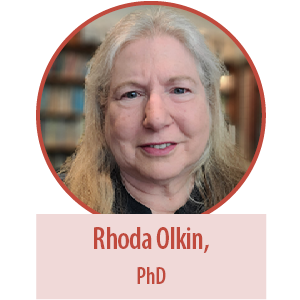
- Affirmative language to reflect the family’s model(s) of disability
- Common pitfalls in the use of assistive technology
- Incorporate the family system to maximize recovery and wellness
- Tools to manage cognitive issues
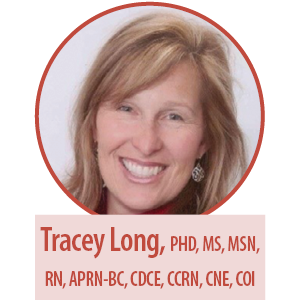
- Pathophysiology, treatment, and pharmacological management for diabetes, hyperlipidemia, and hypertension
- Explore the relationship between hypertension, hyperlipidemia, smoking, diabetes, and stroke
- Common pharmacology seen in rehab facilities
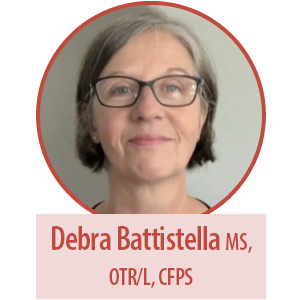
- Integrate visual feedback to stimulate neuroplasticity
- Cost-effective interventions to improve motor control, sensory awareness, and ADL performance

- Site-specific changes within the brain that affect behavior and thinking skills
- Predict patient barriers to engagement and compliance to enhance your treatment plan
Just $399.99 Today!
Not sure of your schedule? No problem! Pre-order the self-study version here!
FREE BONUS! CSRP Certification (a $199.99 value) included!
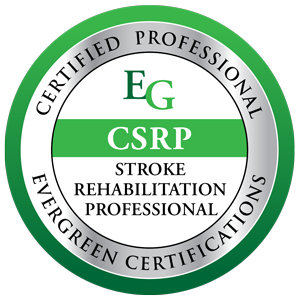 In just a few simple steps, you can become an Evergreen Certified Stroke Rehabilitation Professional (CSRP):
In just a few simple steps, you can become an Evergreen Certified Stroke Rehabilitation Professional (CSRP): Step 1: Complete this live interactive training and the additional self-study modules.
Step 2: Complete the CE tests and instantly print your certificates of completion.
Step 3: Submit the Certification Questionnaire included in this training to Evergreen Certifications and we'll cover the cost of your certification for the first year (a $199.99 value!).* Click here for full Certification requirements
That's it! No hidden fees. No catch. Just certification made EASY.
*Professional standards apply. Learn more at www.evergreencertifications.com/CSRP
We're that confident you'll find this learning experience to be all that's promised and more than you expected.


